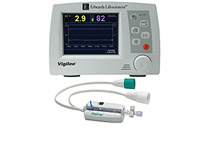Difference between Scvo2 and Svo2

Monitor measures venous oximetry
Scvo2 vs Svo2
Svo2 stands for mixed venous saturation of oxygen. It is basically the percentage of oxygen remaining in the venous blood returning to the right side of the heart. This is the oxygen left over in the blood after supplying all the parts of the body except the head. It indicates the amount of oxygen in venous blood after the body’s tissues have taken up their share of oxygen. Scvo2 stands for central venous oxygen saturation. It is the oxygen saturation of venous blood coming from the head and upper body. It is measured from the superior vena cava, that drains blood from the head and upper body to the heart and thus, it is called as central venous oxygen saturation.
The normal level of Svo2 is 60% and Scvo2 is usually 2-3% lower than Svo2. This is because the lower half of the body extracts less oxygen and the brain extracts more oxygen than other organs of the body. Together, both the saturation percentages give us knowledge about the balance between the delivery of oxygen and oxygen consumption in the body. The procedure for assessing Scvo2 is less risky and has far lesser complications than measuring Svo2. While collecting blood samples for checking Scvo2, the blood is collected from the superior vena cava by placing a thin, fibreoptic central venous catheter in the jugular vein. In case of Svo2, the value is assessed by taking an average by collecting 3 samples from three different regions- first sample from the lower limbs, second sample combined from head and upper limbs and third from cardiac venous supply. If not an average, blood sample can be directly taken from the pulmonary artery. A pulmonary artery catheter is used for this procedure. The pulmonary artery carries the venous blood from the right ventricle of the heart to the lungs for oxygenation. Taking sample from this artery is a highly invasive procedure and hence, has more chances of complications. This is a major difference between collection of sampled for Svo2 and Scvo2.
Alteration in Scvo2 levels is seen in cardiopulmonary disease patients. Scvo2 values are used for evaluation in cases of patients with severe shock, severe sepsis, acutely decompensated heart failure, cardiac arrest, traumatic and hemorrhagic shock. It is important to measure Scvo2 or Svo2 in patients because even if we measure cardiac output it will not show whether a patient is improving or not. A series of values of Scvo2 or Svo2 will give ample information about patient’s progress. Scvo2 values are more than Svo2 in cases of anesthesia, cerebral metabolism, depression and shock as in these cases the oxygen requirement of brain tissues are lesser due to the comatose state. If the cardiac output increases or tissue extraction of oxygen increases or if lactose metabolism increases then it is important to measure saturation levels. It helps to pin point the exact cause of the deranged saturation levels. Rarely, in cases where Svo2 is not obtainable then Scvo2 is measured and used as Svo2. If saturation levels of only the cranial venous blood are needed then Scvo2 levels are taken. Decreasing levels of Scvo2 and Svo2 are seen in cases where oxygen delivery reduces or there is an increase in oxygen consumption.
Summary: Scvo2 measures central venous oxygen saturation level from veins draining the head and upper body while Svo2 measures mixed venous oxygen saturation from the lower half of the body. Scvo2 is more conveniently measured and less risky than Svo2 measurement.
- Difference between near sightedness and far sightedness - January 21, 2015
- Difference between Diverticulosis and Diverticulitis - January 20, 2015
- Difference between Prilosec and Nexium - January 19, 2015
